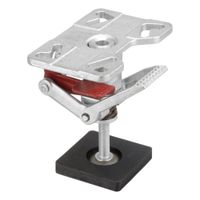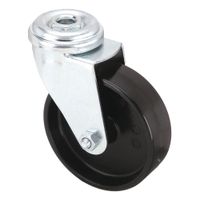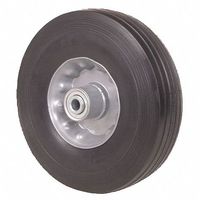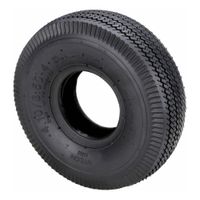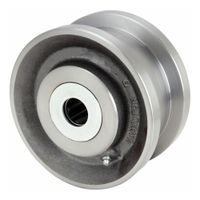Call +(254) 703 030 000 / 751 483 999 / 721 704 777
- Home
- Material Handling
- Casters Wheels
.....Read More
Frequently Asked Questions
What are the different types of casters and wheels?
Casters and wheels are essential components for mobility in various applications, from industrial machinery to furniture. They come in a wide array of types, each designed for specific purposes and environments.
Casters are assemblies that include a wheel, a bracket (rigging), and a swivel mechanism, allowing for directional changes. Key types of casters include: * **Swivel Casters:** These allow 360-degree rotation, offering maximum maneuverability. They are ideal for applications requiring frequent changes in direction, such as carts in warehouses or office chairs.
* **Rigid (Fixed) Casters:** These casters are fixed in one direction, providing stability and straight-line tracking. They are often used in conjunction with swivel casters to create a controlled movement system, for example, on dollies or platform trucks.
* **Braking Casters:** Equipped with various braking mechanisms (e.g., total lock, top lock, side lock), these casters prevent movement, securing equipment in place. They are crucial for safety in applications like medical equipment or scaffolding.
* **Kingpinless Casters:** Designed for heavy-duty applications, these casters eliminate the kingpin, a common point of failure, enhancing durability and load capacity.Wheels, the rolling component of a caster, also come in diverse materials and designs: * **Polyurethane Wheels:** Known for their durability, shock absorption, and non-marking properties, they are versatile and suitable for various floor types and loads.
* **Rubber Wheels:** Offering good traction and cushioning, rubber wheels are quiet and protect floors, making them suitable for indoor use and delicate surfaces.
* **Nylon/Phenolic Wheels:** These hard wheels are ideal for heavy loads and rough surfaces, offering high load capacities and resistance to chemicals.
* **Cast Iron Wheels:** Extremely robust, cast iron wheels are designed for the heaviest loads and can withstand harsh industrial environments, though they can be noisy and may damage floors.
* **Pneumatic Wheels:** Filled with air, these wheels provide excellent cushioning and shock absorption, making them suitable for uneven terrain and outdoor applications.The choice of caster and wheel type depends on factors like load capacity, floor type, environment (e.g., temperature, chemicals), desired maneuverability, and specific application requirements.
How do I choose the right caster for my equipment?
Choosing the right caster for your equipment involves considering several factors to ensure optimal performance, durability, and safety.
First, assess the weight capacity required. Each caster has a maximum load rating, and the total weight of the equipment plus its contents should be distributed among the casters. For instance, if you have four casters, divide the total load by three to give yourself a safety margin, as not all casters may bear an equal load at all times.
Next, consider the type of flooring the equipment will be used on. Hard wheels (like steel or cast iron) are suitable for soft floors (carpet, asphalt), while soft wheels (like rubber or polyurethane) are better for hard floors (concrete, tile) as they provide better traction and floor protection.
The environment of operation is also crucial. Factors such as extreme temperatures, moisture, chemicals, or abrasive materials will influence the material of the wheel and the finish of the caster rig. For example, stainless steel casters are ideal for washdown environments or areas with corrosive substances.
Maneuverability requirements should also be taken into account. Swivel casters allow for 360-degree rotation and are great for tight spaces, while rigid casters provide directional stability for straight-line movement. Often, a combination of both is used.
Finally, consider any special features needed, such as brakes (total lock or wheel lock), shock absorption for delicate equipment, or quiet operation. By carefully evaluating these factors, you can select the most appropriate caster solution for your specific application.
What is the difference between plate-mount and stem casters?
The primary difference between plate-mount and stem casters lies in their method of attachment. Plate-mount casters feature a flat top plate with pre-drilled holes, which are secured to the bottom of the equipment using screws or bolts. This provides a broad, stable attachment point, distributing the weight over a larger surface area, making them suitable for heavier loads and applications where robust stability is crucial.
Stem casters, on the other hand, have a cylindrical stem that inserts into a corresponding socket or receiver on the equipment. There are various types of stems, including threaded stems that screw into a threaded insert, grip ring stems that use a spring-loaded ring to hold the stem in place, and expander stems that expand to create a secure fit within a hollow tube. Stem casters are often favored for lighter to medium-duty applications and furniture, where a more discreet or quick-release attachment is desired. They offer greater maneuverability in some cases due to their single point of attachment, allowing for easier rotation and directional changes.
In summary, plate-mount casters offer superior stability and weight capacity due to their broad attachment, while stem casters provide versatility and ease of installation for lighter applications. The choice between the two depends on the specific weight requirements, type of equipment, and desired mobility.
How do I install bolt-hole casters?
Installing bolt-hole casters involves a few straightforward steps. First, ensure you have the correct casters for your application, considering the weight capacity and wheel material. You'll also need appropriate bolts, washers, and nuts, typically sized to fit the caster's bolt hole.
Begin by aligning the caster's bolt-hole plate with the desired mounting location on the equipment or furniture. Mark the exact spot where the bolt will pass through. If drilling is required, use a drill bit slightly larger than your bolt to create a clean hole.
Next, insert the bolt through the mounting surface and then through the caster's bolt hole. Place a washer on the bolt before securing it with a nut. Tighten the nut firmly, but be careful not to overtighten, which could damage the mounting surface or the caster. Repeat this process for all casters. Once installed, test the casters to ensure they swivel and roll smoothly.
What are the benefits of pneumatic wheels?
Pneumatic wheels offer several key benefits due to their air-filled design. They provide excellent shock absorption, which translates to a smoother ride over uneven terrain and reduces vibrations transmitted to the equipment or operator. This cushioning effect also helps protect delicate cargo from damage. Their large contact patch and flexible nature allow for superior traction on various surfaces, including loose gravel, dirt, and wet conditions, by conforming to the ground. This improved grip enhances stability and control. Additionally, the ability to adjust tire pressure allows for customization based on the load and terrain, optimizing performance and comfort. This versatility makes pneumatic wheels ideal for applications ranging from bicycles and wheelchairs to industrial equipment and vehicles where comfort, traction, and protection of goods are paramount.
How do I maintain and care for my casters and wheels?
Maintaining and caring for your casters and wheels is crucial for their longevity and optimal performance. Regular cleaning is the first step: remove any accumulated dirt, dust, hair, or debris that can hinder movement and cause wear. A simple wipe-down with a damp cloth is often sufficient, but for stubborn grime, a mild soap solution can be used. Ensure the casters are thoroughly dried afterward to prevent rust, especially on metal components.
Lubrication is another key aspect, particularly for swivel casters and those with bearings. Apply a silicone-based spray or a light grease to the swivel bearings and axle points. This reduces friction, prevents squeaking, and ensures smooth rotation. Avoid petroleum-based lubricants as they can attract more dirt and potentially damage certain wheel materials over time.
Periodically inspect your casters for signs of wear and tear. Check the wheels for flat spots, cracks, or excessive abrasion. Look for loose or damaged fasteners, and tighten them if necessary. If a wheel is significantly worn or damaged, it's best to replace it to prevent uneven weight distribution and potential damage to the equipment. For casters used on sensitive flooring, ensure the wheel material is appropriate to prevent scratches or marks. Following these maintenance steps will significantly extend the life of your casters and wheels and ensure they operate efficiently.
What are flat-free wheels and when should they be used?
Flat-free wheels, also known as solid or semi-pneumatic tires, are designed to eliminate the risk of punctures and flats. Unlike traditional pneumatic tires that are filled with air, flat-free wheels are made from solid materials like polyurethane, rubber, or foam, or they have an inner core that resists compression.
They are particularly useful in environments where punctures are common, such as construction sites, workshops, and gardens, where sharp objects like nails, glass, or thorns might be present. Industries that frequently use equipment with flat-free wheels include landscaping, material handling (e.g., hand trucks, dollies), and some types of mobility aids.
The main advantage of flat-free wheels is their durability and the absence of downtime due to tire maintenance. This translates to increased productivity and reduced operational costs. However, they typically offer less cushioning than pneumatic tires, which can result in a harsher ride and potentially more vibration. They also tend to be heavier and can sometimes have less traction on certain surfaces.
Therefore, flat-free wheels should be used when reliability and puncture resistance are paramount, and when the trade-off in cushioning or weight is acceptable for the application.
How do I replace a caster wheel?
To replace a caster wheel, first, ensure the furniture or object is stable and won't move during the process. If possible, tilt or lay the item on its side to easily access the caster. Most caster wheels are either stem-mounted or plate-mounted.
For stem-mounted casters, which often have a cylindrical stem inserted into a socket, you'll typically need to pull the old caster out. This might require some force, or you might need a pry tool to loosen it. Some stem casters have a circlip or a small locking mechanism that needs to be released first. Once the old one is out, simply push the new stem-mounted caster firmly into the socket until it's secure.
For plate-mounted casters, which are attached with a flat plate and screws, use a screwdriver or drill to remove the screws holding the old caster in place. Once the screws are removed, the old caster can be taken off. Align the new plate-mounted caster with the screw holes and secure it by re-inserting and tightening the screws.
After installing the new caster, carefully return the furniture to its upright position and test the new wheel's movement to ensure it rolls smoothly and is securely attached.
What accessories are available for casters and wheels?
For casters and wheels, a variety of accessories are available to enhance their functionality, durability, and safety. These accessories can significantly improve performance in diverse applications, from industrial settings to furniture.
One common category of accessories includes brakes. Various types of brakes, such as total lock brakes, top lock brakes, and side lock brakes, can be added to casters to prevent movement when necessary, providing stability and safety. Swivel locks are another crucial accessory, allowing users to switch between swivel and rigid modes, which is particularly useful for steering control in transport applications.
Beyond mobility control, floor locks or jacks are available to provide additional stability for equipment that needs to remain stationary, preventing unwanted rolling. Bumpers, made from materials like rubber or non-marking plastic, can be attached to protect walls, equipment, and the casters themselves from impact damage.
For specific environments, accessories like thread guards can prevent debris, such as string or hair, from wrapping around the axle and hindering wheel rotation. Bearing seals can also be added to protect the bearings from dirt, dust, and moisture, extending the lifespan of the casters, especially in harsh conditions. Mounting plates, expander stems, and different types of inserts are also available to facilitate secure attachment to various equipment and structures. Lastly, ergonomic handles or foot pedals can be integrated for easier engagement of brakes or swivel locks, improving user experience and operational efficiency.
How do track wheels work and what are their applications?
Track wheels, also known as rail wheels or railway wheels, are a fundamental component of railway systems, enabling trains and other rail-bound vehicles to move efficiently along tracks. Their primary function is to support the vehicle's weight and guide it along the rails.
The working principle of track wheels is based on a combination of shape and material properties. The wheel typically has a flange, which is a rim that extends beyond the tread. This flange prevents the wheel from derailing by providing lateral guidance against the inner edge of the rail. The wheel's tread, the part that makes contact with the rail, is often coned or tapered. This conicity helps the wheels self-center on the track and allows for smooth negotiation of curves. When a train enters a curve, the coned wheels cause one wheel to travel on a slightly larger diameter and the other on a smaller diameter, effectively compensating for the difference in track length around the curve without slippage.
Track wheels are made from high-strength steel alloys to withstand immense loads, wear, and fatigue. They are designed to maintain a low rolling resistance, which contributes to energy efficiency in rail transport.
Applications of track wheels are extensive and include: * **Freight Trains:** Moving large quantities of goods over long distances.
* **Passenger Trains:** Including high-speed rail, commuter trains, and subways, for efficient passenger transport.
* **Trams and Light Rail:** Urban transport systems that operate on rails.
* **Industrial Applications:** Such as cranes, transfer cars, and other heavy machinery that operate on rail systems within industrial facilities.
* **Mining:** Locomotives and specialized rail vehicles used for transporting ore and materials in mines.In essence, track wheels are crucial for the safety, efficiency, and widespread application of rail transport across various industries and for both freight and passenger movement.
